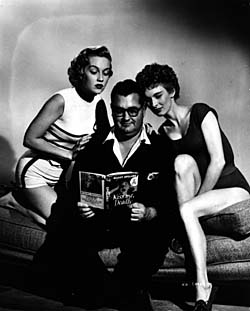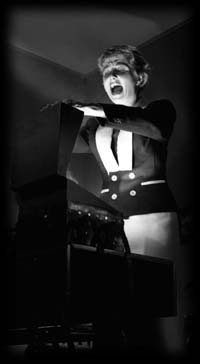|
On the script page, Bezzerides clearly specified that Mike Hammer and Velda (played by Ralph Meeker and Maxine Cooper) do not perish in the fatal Malibu beach house. Instead they escape to the relative safety of the beach, from where they observe the house as it continues to burn. Fade out.
On the screen, one of the most distinctive aspects of Kiss Me Deadly was the outrageousness of its final few seconds: the movie didn't conclude—it detonated. Hammer and Velda are never actually shown to escape the burning building. Instead we see the beach house burning and exploding (in a rather dreamlike way—the structure boils with fire, but seems to remain intact) and the film just ENDS at peak tension.

There is an extremely disturbing lack of resolution: Do they escape? What about Hammer's bullet wound? Or the possibly fatal dose of radiation from the burn on his wrist? And what is that crazy box, anyway? Just as the movie is about to wind up—the movie explodes. No continuity. No coherence. On the surface, this looked like something from the French New Wave, only several years too soon. Most viewers of this jarring, dislocating ending reacted with awe for its stark raggedness, and then leapt to the immediate conclusion that the entire world would be consumed in a nuclear fire.
Telltale editorial evidence
Poetic as this ending was, Alain knew it was truncated. I agreed. Even to a student just learning about film editing, the very end of Kiss Me Deadly showed all the signs of bogus film manipulation:
- As soon as Hammer and Velda leave the screen, the print quality worsens, and does not improve, throughout the ending which comes only 18 seconds later.
- The remaining four shots of the exploding house, taken from slightly varied angles, are awkwardly jump-cut together. There's some pretty extreme cutting elsewhere in Aldrich's filmography, but nothing this disjointed.
- Superimposed over the last shot is a "The End" title that zooms forward in a pedestrian way inconsistent with Kiss Me Deadly's truly hip main titles and their inverted/correct messages.
- The picture ends with a poor quality fade that looks as if it were made with a timing change in the printer.
- Finally, the music score just chops off in mid-bar, an obvious hatchet job.
Editorially speaking, the ending looks less like Godard, and more like gobbledegook. I made a point of catching a number of revival screenings of Kiss Me Deadly throughout the '80s, hoping to see some variant ending. The picture always ended the same, and I remained convinced that something was seriously wrong about the end of this picture.

Publicity still of Robert Aldrich reading
Mickey Spillane's Kiss Me Deadly
(with Marian Carr and Cloris Leachman).
In 1992, the subject came up once again with Alain Silver. At that time he was intrigued by foreign references to a version of the film where the protagonists indeed reached the surf as they had in the screenplay. Alain also had read an interview where Aldrich himself claimed not to be aware of any ending except Hammer and Velda stumbling to the waterline, even though their fate after the fade out is in grave doubt. Finally Alain showed me a still frame blowup from an English publication showing THE END superimposed, not over the burning house, but instead over a new angle of the couple floundering in the Pacific Ocean. Almost concurrently, MGM Home Video released its laserdisc of Kiss Me Deadly with the added bonus of the original trailer. It was actually the textless original trailer meant for foreign markets to superimpose their own advertising copy ("white hot kisses!") in whatever language was required; the trailers with text, like many others, had probably been lost. This trailer on the laserdisc was probably meant to have scrolling ad copy over every scene where voiceover wasn't heard, including one very special shot—Hammer and Velda stumbling in the surf.
This was the shock wave that began the restoration. Soon the surf scene was mentioned every time Kiss Me Deadly came up in a conversation. Tim Lucas dutifully reported it in his Video Watchdog. Mention of the controversy showed up in Alain's book What Ever Happened to Robert Aldrich?, and then his original Images article was written (issue #2/November 1996). In it Alain used the scene numbers in the script to extrapolate that two or three shots were missing. At that time, we both believed that if the missing ending to Kiss Me Deadly were ever found it would add at most only ten or fifteen seconds to the film.
Finally, late in 1996, discussing the subject with Alain one more time, I said that someone somewhere has to have an original print of this film. To my surprise Alain responded by saying that he might know how to find one. Aldrich's personal print, which could very well be a 1955 original, had been donated to the Director's Guild of America after his death in 1983. I called John Kirk, archivist with MGM, the present owners of the film, while Alain secured permission to access the Aldrich print from Selise Eiseman of the Special Projects committee of the DGA. John Kirk verified that UA's 35mm original negative indeed was the familiar truncated version. A couple of incorrect prints were screened, and finally the real Aldrich print showed up. On Jan. 31 we watched the final reel of Kiss Me Deadly once more, expecting nothing and hoping for a surprise.
page 1 of 2

Photo credits: MGM/UA. All rights reserved.
|





